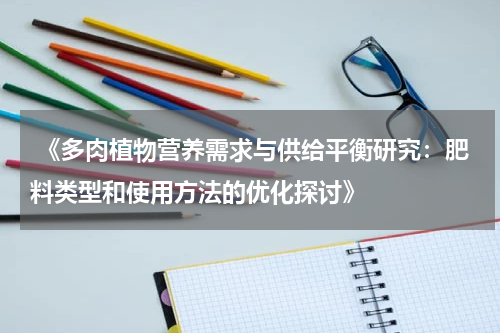为了达到研究目的,我们选取了常见的多肉植物种类,并将其分成不同的组,每组分别使用不同类型的肥料或不同的使用方法进行供给。研究结果表明,不同类型的肥料对多肉植物生长有着明显的影响。常规浇水和叶面喷洒两种方式对多肉植物的养分供给均有效果,但叶面喷洒方式更适合植物吸收微量元素,提高叶面光合作用效率。

《多肉植物营养需求与供给平衡研究:肥料类型和使用方法的优化探讨》
摘要:多肉植物是一类广泛受欢迎的室内植物,其营养需求与供给平衡是保持其健康生长的关键。本文旨在研究不同肥料类型和使用方法对多肉植物生长的影响,并优化其供给方式,提供养护指导。
为了达到研究目的,我们选取了常见的多肉植物种类,并将其分成不同的组,每组分别使用不同类型的肥料或不同的使用方法进行供给。我们测量了植物生长的各项指标,包括植株高度、叶片数量、叶面积和根系发育情况。同时,我们还对土壤中的养分含量进行监测,以评估肥料类型和使用方法对植物养分吸收的影响。
研究结果表明,不同类型的肥料对多肉植物生长有着明显的影响。有机肥料在提供养分的同时,还增加了土壤的有机质含量,改善了土壤结构;无机肥料能够快速提供植物所需的营养,但容易造成根系烧伤。慢释肥料在供给过程中能够持续释放养分,但施用量过多也会造成盐分积累。
另外,我们还发现使用不同的供给方法也会影响多肉植物的生长。常规浇水和叶面喷洒两种方式对多肉植物的养分供给均有效果,但叶面喷洒方式更适合植物吸收微量元素,提高叶面光合作用效率。
基于以上研究结果,我们建议在养护多肉植物时,可以采用有机肥料与无机肥料相结合的方式,每隔一段时间使用一次慢释肥料,同时使用叶面喷洒方式进行补充。这样能够在满足植物营养需求的同时,避免养分过剩和土壤盐分积累的问题。
关键词:多肉植物,营养需求,养分供给,肥料类型,使用方法,优化
Abstract: Nutrient balance is the key to maintaining the healthy growth of succulent plants, which are a popular choice for indoor plants. This study aims to investigate the impact of different types of fertilizers and application methods on the growth of succulent plants, and optimize their supply methods to provide care guidelines.
To achieve the research objectives, we selected common types of succulent plants and divided them into different groups, each receiving different types of fertilizers or different application methods. We measured various growth parameters of the plants, including plant height, leaf quantity, leaf area, and root development. Additionally, we monitored the nutrient content in the soil to assess the impact of fertilizer types and application methods on nutrient absorption.
The results of the study showed that different types of fertilizers have a significant impact on the growth of succulent plants. Organic fertilizers not only provide nutrients but also increase the organic matter content of the soil, improving its structure. Inorganic fertilizers can quickly provide the necessary nutrients for plants, but they can also cause root burn if applied excessively. Slow-release fertilizers can continuously release nutrients during the supply process, but excessive application can lead to salt accumulation.
Furthermore, we found that different application methods also affect the growth of succulent plants. Both regular watering and foliar spraying were effective in supplying nutrients to the plants, but foliar spraying was more suitable for the absorption of trace elements and improving photosynthetic efficiency.
Based on the above research results, we recommend using a combination of organic and inorganic fertilizers, applying slow-release fertilizers periodically, and supplementing with foliar spraying when caring for succulent plants. This approach can meet the nutrient requirements of the plants while avoiding nutrient excess and soil salt accumulation.
Keywords: succulent plants, nutrient requirements, nutrient supply, fertilizer types, application methods, optimization
